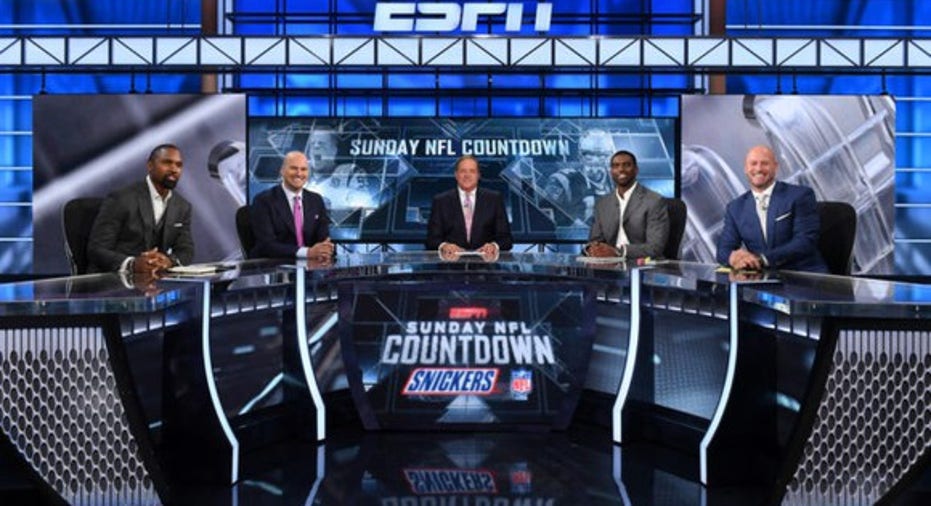ESPN Spends More on Content Than Anyone Else, Including Netflix

Image source: ESPN.
The Worldwide Leader in Sports has to pay a pretty penny to maintain that title. Boston Consulting Group and SNL Kagan project that Disney's (NYSE:DIS) ESPN will spend $7.3 billion on content this year. That's more than any other network, including Netflix (NASDAQ:NFLX), which expects to spend $5 billion this year and $6 billion next year. The next closest traditional television network is NBC, with an estimated budget of $4.3 billion this year.
Importantly, much of ESPN's content spend is locked up in long-term agreements. That puts added pressure on Disney to slow the number of subscribers ditching its most expensive network through cord-cutting or cord-shaving, and compels them to raise the rates it charges distributors.
ESPN's long-term agreements
ESPN has a ton of content expenses locked in through the rest of the decade. Here's just a few of its long-term contracts.
*Split $2.6 billion annual contract with Turner. **Split $200 million annual contract with Fox. ***Details of the newest contract weren't disclosed, but its previous contract was for $155 million per year.
ESPN is paying nearly $5.5 billion for the rights to just nine sports leagues. Add on its smaller contracts for soccer, tennis, NASCAR, and other sporting events, and it's easy to see how it can quickly get to $7.3 billion in content spend. Keep in mind, it also produces its own daily and weekly news shows, such as SportsCenter, as well as sports documentaries. Additionally it has to pay to produce the television broadcasts of the sporting events it holds the rights for.
Between the NFL, NBA, MLB, and College Football Playoff, ESPN has $33.27 billion in long-term content obligations. That blows Netflix's oft-scrutinized long-term content obligations out of the water. Netflix has $7.9 billion of content obligations that aren't recognized on its balance sheet as of the end of the third quarter -- $14.4 billion of total obligations.
But ESPN is losing subscribers
Last year, Disney reported that ESPN lost 3 million subscribers, dropping to 92 million. That's down from 99 million at the end of fiscal 2013. Throughout 2016, various reports suggested ESPN continued to lose subscribers.
Disney plans to combat its subscriber losses by focusing on getting its network into more skinny bundles from both traditional and digital distributors. It's already confirmed it will be included in the paid tiers of AT&T's upcoming DirecTV Now streaming service, and it's likely to be part of Hulu and YouTube's upcoming services.
However, Disney may be making some concessions on how much it charges for ESPN or how quickly it ramps up its carriage fees. Management says it can produce more ad revenue per subscriber on digital platforms thanks to better ad targeting and dynamic ad insertion, so that can help make up for slower ramp-ups in carriage fees. The network has thus far made up for its declining subscriber base with higher fees charged to distributors and advertising rates.
A look at operating income
Even with its huge and rising content costs, ESPN has been able to increase its revenue faster. In fact, Disney's cable networks saw its revenue and operating income each rise 3% through the first nine months of 2016. Still, that's a significant slowdown from last year, when it increased cable networks revenue 10% and operating income 5%.
If ESPN continues to bleed subscribers, it will feel pressure on both its advertising revenue (since it has a smaller potential audience) and its affiliate fees. What's more, it could prove more difficult for it to work out further contractual rate increases when it comes to making deals with distributors.
ESPN already charges over $8 per month per subscriber between ESPN and ESPN2, according to estimates from SNL Kagan. It's unclear how much more it can squeeze from distributors, which themselves are working to keep prices low and keep subscribers.
With billions of content obligations locked in for at least the next next five years, ESPN faces a big challenge to increase revenue one way or another in order to appease Wall Street's expectations. Cable networks accounted for 42% of Disney's operating income through the first nine months of 2016. Continued earnings growth at ESPN will be key to meeting analysts' expectations of double-digit earnings growth over the next five years.
A secret billion-dollar stock opportunity The world's biggest tech company forgot to show you something, but a few Wall Street analysts and the Fool didn't miss a beat: There's a small company that's powering their brand-new gadgets and the coming revolution in technology. And we think its stock price has nearly unlimited room to run for early in-the-know investors! To be one of them, just click here.
Adam Levy has no position in any stocks mentioned. The Motley Fool owns shares of and recommends Netflix and Walt Disney. Try any of our Foolish newsletter services free for 30 days. We Fools may not all hold the same opinions, but we all believe that considering a diverse range of insights makes us better investors. The Motley Fool has a disclosure policy.



















